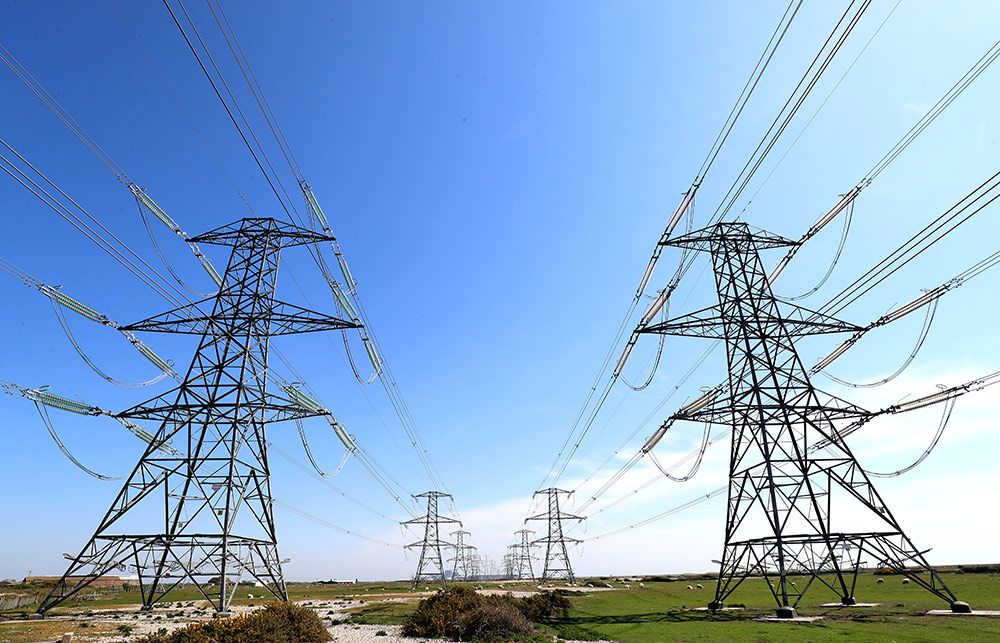
隨著英國在春季實施全國性封鎖政策,,“前所未有”一詞屢屢被搬出來,來形容諸如關閉酒吧,、全民致敬醫(yī)護人員等事情,。
但對于該國的電力運營商英國國家電網公司來說,“前所未有”這詞卻意味著打破一個又一個紀錄(大多比原計劃提前了數(shù)年實現(xiàn)),,比如最大的太陽能容量,、有史以來最低的碳強度(就在上個周日實現(xiàn)了),以及最長的無煤期,。
到了周二,,最長無煤期這一紀錄仍在刷新中,英國的電力系統(tǒng)現(xiàn)在已經連續(xù)錄得46個無煤日(超過1000個小時),。截至周二中午,,無碳發(fā)電量占英國電網的53%,其余包括天然氣發(fā)電,、生物質發(fā)電,,以及小部分進口電能。
英國國家電網突然轉向低碳能源系統(tǒng),,這一舉措并不令人意外,,它的目標是到2025年使英國的電力系統(tǒng)完全脫碳。這次的封鎖制造出了一個在疫情結束后仍會繼續(xù)存在的試驗場,,從中可以一窺未來幾年里新能源將如何影響到國家電網的運營,。這會帶來各種新挑戰(zhàn),比如怎么應對超低需求的時期,怎么處理負定價問題,。此外,,一個依賴于不穩(wěn)定的風力和太陽能的能源系統(tǒng)的脆弱性,又該怎么去應對,?
封鎖政策影響能源消耗
英國于3月下旬實施封鎖,,當即就影響到了能源的消耗:國家電網稱,整個電力系統(tǒng)的需求下跌了20%,。
隨著人們待在家中,,一天到晚開著電視和洗衣機,家庭用電急劇增加,,然而工業(yè)用電的下降更為劇烈,,抵消了這一增長。雖然用電量下降得很大,,但用電模式并不像我們以為的那樣會發(fā)生很大變化:人們在早上為新一天做準備時會消耗更多電量(由于不必通勤,,大家往往會稍晚一點起床),到了晚上因為煮飯和看電視,,用電量又會增多,。
國家電網的市場主管凱特?奧尼爾說,用電需求的急劇下降并不會讓電力系統(tǒng)更容易管理,,反而變得困難,。電力需求下降要求非常精細的調節(jié),以緩解系統(tǒng)電壓同步下降的問題,,使整個系統(tǒng)保持平衡,,同時還要管控對鄰國愛爾蘭和歐洲大陸的電能輸出和輸入。電網系統(tǒng)的調節(jié)稍不到位,,就有斷電的風險,。
英國國家電網一直想讓整個電網“脫碳”,因此開始趁此機會采用了一部分脫碳方案:準備讓英國一個核電站降低發(fā)電量,,并開始討論增加或減少可再生能源小供應商(比如小型太陽能農場或者安裝在工業(yè)區(qū)的系統(tǒng))的供應,,不管增加或減少,它們都不足以對大型電網產生影響,。
奧尼爾說:“在這個低能源需求的時期所做的事情加速了這些變化,。”她稱,,原本要花數(shù)年實施的工作,,突然在5到10天就完成了。
在這個低能源需求的世界,,煤炭注定成為了犧牲品,。奧尼爾說,,雖然在“典型的高需求”日子里,需要動用所有的能源類型,,但能源是按成本順序進入到電網中的,,而煤炭最昂貴。她還說,,在用電需求減少,,尤其是太陽能發(fā)電量創(chuàng)下紀錄(陽光明媚的春季起到了重要作用)的情況下,煤炭實在是顯得太貴了,,毫無存在的必要,。這是長期趨勢的一部分:據(jù)國際能源署,2019年英國的煤炭發(fā)電量跌至2%,,而可再生能源發(fā)電量卻占40%,。

國際能源署稱,,煤炭需求受到沖擊一直是全球實施封鎖的一個特征,。預計今年煤炭需求將下降8%,。可再生能源更容易實現(xiàn)碳減排(比如,,跟飛機相比),,在電網系統(tǒng)中的地位因此更高,而隨著需求下降,,它們所占的比重更大了,。這有利于減少碳排放,但也給運營帶來了挑戰(zhàn),,問題主要在于要確保一直都有可靠的備用能源(通常是水電或核電的形式),,以維持穩(wěn)定的供應,就像過去的煤炭一樣,。
保持能源系統(tǒng)平衡是非常精細周密的流程,,掌控好這個流程還需要其它的創(chuàng)造性措施,以確保有足夠的身體健康的工程師在控制室里運行電網,。這需要好好規(guī)劃才行,。封鎖期間,一些員工需要把上班的地方當成家(他們住在一個個艙室中),,連續(xù)幾個星期不見家人,。
在某些情況下,用電需求下降還造成了市場上的一些怪現(xiàn)象:在英國以及其它歐洲國家,電力市場嚴重供過于求,,以至于在近幾個月內,,價格反復跌至負值——這實際上是要電企付錢給消費者去用電。在高效能源儲存技術出現(xiàn)和應用之前,,這種能源傾銷的現(xiàn)象將一直是個問題,。
如何重啟電網
奧尼爾說,盡管英國首相約翰遜在本月初宣布稍微放松該國的封鎖措施,,不過能源需求仍然低迷,。雖然現(xiàn)在民眾能待在外面的時間更長了,但政府已經表示,,非必要商店等場所直到6月中旬才可以開放,。
不過,,恢復至“正常”的能源需求并非是問題所在,。
奧尼爾說:“隨著需求上升,,如果說有什么不同的話,那就是電力系統(tǒng)變得容易管理了,?!彼€補充說,國家電網仍然在觀察,,看新冠病毒帶來的潛在長期轉變(比如通勤減少了,,居家工作的人多了)是否會顯著改變英國的電力消費模式。
不管怎樣,,國家電網一直在為“低需求的夏天”而做準備,,并將封鎖期間的舉措繼續(xù)實施下去。在此期間,,他們也做到了一些之前從來沒有做到的事,。
奧尼爾說,這次疫情表明,,英國各個行業(yè)能更密切地攜手合作,并且英國實現(xiàn)其脫碳里程碑的日期也可能遠早于預期,。 (財富中文網)
譯者:李耀和
隨著英國在春季實施全國性封鎖政策,,“前所未有”一詞屢屢被搬出來,來形容諸如關閉酒吧,、全民致敬醫(yī)護人員等事情。
但對于該國的電力運營商英國國家電網公司來說,,“前所未有”這詞卻意味著打破一個又一個紀錄(大多比原計劃提前了數(shù)年實現(xiàn)),比如最大的太陽能容量,、有史以來最低的碳強度(就在上個周日實現(xiàn)了),,以及最長的無煤期,。
到了周二,,最長無煤期這一紀錄仍在刷新中,,英國的電力系統(tǒng)現(xiàn)在已經連續(xù)錄得46個無煤日(超過1000個小時)。截至周二中午,,無碳發(fā)電量占英國電網的53%,,其余包括天然氣發(fā)電,、生物質發(fā)電,,以及小部分進口電能,。
英國國家電網突然轉向低碳能源系統(tǒng),,這一舉措并不令人意外,,它的目標是到2025年使英國的電力系統(tǒng)完全脫碳,。這次的封鎖制造出了一個在疫情結束后仍會繼續(xù)存在的試驗場,,從中可以一窺未來幾年里新能源將如何影響到國家電網的運營。這會帶來各種新挑戰(zhàn),,比如怎么應對超低需求的時期,,怎么處理負定價問題,。此外,,一個依賴于不穩(wěn)定的風力和太陽能的能源系統(tǒng)的脆弱性,,又該怎么去應對?
封鎖政策影響能源消耗
英國于3月下旬實施封鎖,,當即就影響到了能源的消耗:國家電網稱,,整個電力系統(tǒng)的需求下跌了20%,。
隨著人們待在家中,一天到晚開著電視和洗衣機,,家庭用電急劇增加,然而工業(yè)用電的下降更為劇烈,,抵消了這一增長,。雖然用電量下降得很大,,但用電模式并不像我們以為的那樣會發(fā)生很大變化:人們在早上為新一天做準備時會消耗更多電量(由于不必通勤,,大家往往會稍晚一點起床),到了晚上因為煮飯和看電視,,用電量又會增多,。
國家電網的市場主管凱特?奧尼爾說,,用電需求的急劇下降并不會讓電力系統(tǒng)更容易管理,,反而變得困難。電力需求下降要求非常精細的調節(jié),,以緩解系統(tǒng)電壓同步下降的問題,,使整個系統(tǒng)保持平衡,同時還要管控對鄰國愛爾蘭和歐洲大陸的電能輸出和輸入,。電網系統(tǒng)的調節(jié)稍不到位,,就有斷電的風險,。
英國國家電網一直想讓整個電網“脫碳”,因此開始趁此機會采用了一部分脫碳方案:準備讓英國一個核電站降低發(fā)電量,,并開始討論增加或減少可再生能源小供應商(比如小型太陽能農場或者安裝在工業(yè)區(qū)的系統(tǒng))的供應,,不管增加或減少,它們都不足以對大型電網產生影響,。
奧尼爾說:“在這個低能源需求的時期所做的事情加速了這些變化?!彼Q,原本要花數(shù)年實施的工作,,突然在5到10天就完成了,。
在這個低能源需求的世界,煤炭注定成為了犧牲品,。奧尼爾說,,雖然在“典型的高需求”日子里,需要動用所有的能源類型,,但能源是按成本順序進入到電網中的,,而煤炭最昂貴。她還說,,在用電需求減少,,尤其是太陽能發(fā)電量創(chuàng)下紀錄(陽光明媚的春季起到了重要作用)的情況下,煤炭實在是顯得太貴了,,毫無存在的必要,。這是長期趨勢的一部分:據(jù)國際能源署,2019年英國的煤炭發(fā)電量跌至2%,,而可再生能源發(fā)電量卻占40%,。
國際能源署稱,煤炭需求受到沖擊一直是全球實施封鎖的一個特征,。預計今年煤炭需求將下降8%,。可再生能源更容易實現(xiàn)碳減排(比如,,跟飛機相比),,在電網系統(tǒng)中的地位因此更高,而隨著需求下降,,它們所占的比重更大了,。這有利于減少碳排放,但也給運營帶來了挑戰(zhàn),,問題主要在于要確保一直都有可靠的備用能源(通常是水電或核電的形式),,以維持穩(wěn)定的供應,,就像過去的煤炭一樣。
保持能源系統(tǒng)平衡是非常精細周密的流程,,掌控好這個流程還需要其它的創(chuàng)造性措施,,以確保有足夠的身體健康的工程師在控制室里運行電網。這需要好好規(guī)劃才行,。封鎖期間,,一些員工需要把上班的地方當成家(他們住在一個個艙室中),連續(xù)幾個星期不見家人,。
在某些情況下,,用電需求下降還造成了市場上的一些怪現(xiàn)象:在英國以及其它歐洲國家,電力市場嚴重供過于求,,以至于在近幾個月內,,價格反復跌至負值——這實際上是要電企付錢給消費者去用電。在高效能源儲存技術出現(xiàn)和應用之前,,這種能源傾銷的現(xiàn)象將一直是個問題,。
如何重啟電網
奧尼爾說,盡管英國首相約翰遜在本月初宣布稍微放松該國的封鎖措施,,不過能源需求仍然低迷,。雖然現(xiàn)在民眾能待在外面的時間更長了,但政府已經表示,,非必要商店等場所直到6月中旬才可以開放,。
不過,恢復至“正?!钡哪茉葱枨蟛⒎鞘菃栴}所在,。
奧尼爾說:“隨著需求上升,如果說有什么不同的話,,那就是電力系統(tǒng)變得容易管理了,。”她還補充說,,國家電網仍然在觀察,,看新冠病毒帶來的潛在長期轉變(比如通勤減少了,居家工作的人多了)是否會顯著改變英國的電力消費模式,。
不管怎樣,,國家電網一直在為“低需求的夏天”而做準備,并將封鎖期間的舉措繼續(xù)實施下去,。在此期間,,他們也做到了一些之前從來沒有做到的事。
奧尼爾說,,這次疫情表明,,英國各個行業(yè)能更密切地攜手合作,并且英國實現(xiàn)其脫碳里程碑的日期也可能遠早于預期,。 (財富中文網)
譯者:李耀和
As the U.K. went into nationwide lockdown this spring, the words “unprecedented” were trotted out to explain everything from pubs being closed to national clap-alongs for health care workers.
But for the National Grid, the country’s electricity operator, “unprecedented” meant blowing through one record after another, often years ahead of schedule: max solar capacity in the energy system, lowest-ever carbon intensity—just this Sunday—and longest stretch without coal.
That record was still in place on Tuesday, with the country’s system now on its 46th consecutive coal-free day—over 1,000 hours—and counting. As of midday Tuesday, the country’s grid was 53% carbon-free, with the remainder comprising supplies of gas, biomass, and a small proportion of energy imports.
This sudden shift to a dramatically lower-carbon energy system isn’t an unexpected development inside National Grid—the goal is to completely decarbonize the country’s electricity system by 2025. But the lockdown has produced a kind of testing ground that will outlive the pandemic, giving a taste of how a mix of new energy sources will impact National Grid’s operations in the coming years. This will give rise to new challenges: periods of ultralow demand, negative pricing, and how to manage the delicate balance of an energy system dependent on the fluctuations of wind and sun.
The lockdown drop
When the U.K. went into lockdown in late March, the impact on energy consumption was immediate: Demand dropped about 20% across the system, according to the National Grid.
While domestic demand increased sharply as people stayed home and ran TVs and washing machines all day, that increase was offset by the much sharper decline in industrial consumption. But other than that drop, the patterns of demand didn’t look as different as you might expect: People used more energy in the mornings as they got ready for the day (they just tended to get up a bit later, as commuting was taken out of the equation), and again in the evenings as they cooked and watched TV.
But rather than making the electricity system easier to manage, a drop in demand at that scale makes it harder, says Kayte O’Neill, head of markets at National Grid. A demand drop requires fine brushwork, to ease the system’s voltage down in tandem and keep the entire system in balance, while managing the imports and exports of energy to neighboring Ireland and mainland Europe. Not keeping the system perfectly aligned means risking blackouts.
National Grid turned to programs it had been considering as part of the long-term strategy to decarbonize the whole grid: arranging for one of the U.K.’s nuclear stations to turn down its output, and entering discussions to turn up or down supply by the kinds of smaller renewable producers—mini solar farms or systems installed in industrial parks, for example—that otherwise wouldn’t be significant enough to have an impact on the larger grid.
“What this lower-demand period has done has accelerated those changes,” O’Neill says. Work that was expected to be rolled out over years was suddenly done in as little as five to 10 days, she says.
In this low-demand world, coal is a natural casualty. While a “typical, high-demand” day would draw on the full range of energy sources, O’Neill says, sources of demand are drawn into the grid in order of cost—and coal is the most expensive. With less demand and record supplies of solar power, in particular—a sunny spring has helped—coal is simply too expensive and not necessary, says O’Neill. That’s part of a longer-term trend: in 2019, coal fell to just 2% of electricity generation overall in the U.K., according to the International Energy Agency (IEA), while renewables provided 40%.
That hit to coal demand has been a feature of lockdowns around the world, according to the IEA. Coal demand is expected to drop 8% this year. With demand falling, renewables—which are more highly represented in energy grids, because they are easier to decarbonize than, say, airplanes—have come to make up a larger part of the total energy pie. That’s good for emissions, but it comes with its own operational challenges, largely in making sure that there are always reliable backups (frequently in the form of hydropower or nuclear) to underpin stable supply, the way coal has in the past.
Managing the careful process of keeping the energy system in balance has also required other, creative measures—how to make sure that enough control room engineers would remain healthy in order to run the grid itself. That required planning, with some workers during the lockdown living at work—in pods—and not seeing their families for weeks at a time.
That drop in demand has also produced bizarre market distortions, in some cases: In the U.K. as well as other European countries, power markets have become so oversupplied that prices have repeatedly dipped into negative territory in recent months—effectively requiring utilities to pay consumers to use energy. This kind of energy-dumping phenomenon will continue to be a problem until efficient energy storage technologies can be developed and deployed.
How to reopen the grid
Even after Boris Johnson announced slight easing measures to the country’s lockdown earlier this month, energy demand remained low, says O’Neill. While people can now spend longer outside, nonessential shops—for example—won’t be opened until mid-June, the government has said.
But a return to “normal” energy demand isn’t the concern.
“As demand goes up, if anything the system becomes easier to manage,” O’Neill says, adding that National Grid was still waiting to see whether potential long-term shifts caused by COVID-19—less commuting, more working from home, for example—would markedly shift the country’s electricity consumption patterns.
Either way, the National Grid has been preparing for a “l(fā)ow-demand summer”; keeping in place the measures it has used throughout the lockdowns. New precedents have also been set.
The pandemic showed that every sector of the U.K. is capable of working together in closer cooperation, O’Neill says—and that it may be possible for major decarbonization milestones to be hit far sooner than expected.






